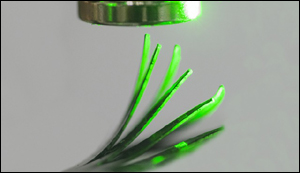Scientists develop new materials that move in response to light
24. 7. 2018 | Tufts University | www.tufts.edu
Researchers at Tufts University School of Engineering have developed magnetic elastomeric composites that move in different ways when exposed to light, raising the possibility that these materials could enable a wide range of products that perform simple to complex movements, from tiny engines and valves to solar arrays that bend toward the sunlight.
The light actuated materials created in this study are based on the principle of the Curie temperature – the temperature above which certain materials will change their magnetic properties. By heating and cooling a magnetic material, one can turn its magnetism off and on. The basic movements of the material, shaped into films, sponges, and hydrogels, are induced by nearby permanent or electromagnets and can exhibit as bending, twisting, and expansion.

Materials used to create the light actuated materials include polydimethylsoloxane (PDMS), which is a widely used transparent elastomer often shaped into flexible films, and silk fibroin, which is a versatile biocompatible material with excellent optical properties that can be shaped into a wide range of forms – from films to gels, threads, blocks and sponges.
Read more at Tufts University
Image Credit: Mike Silver
-jk-




